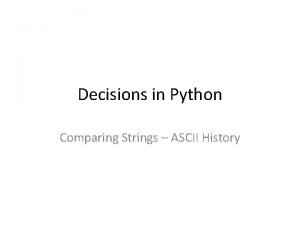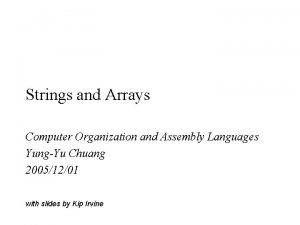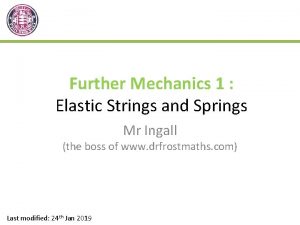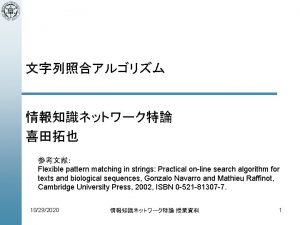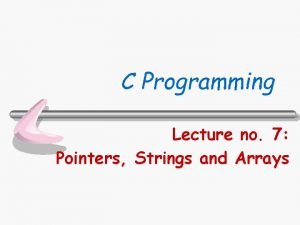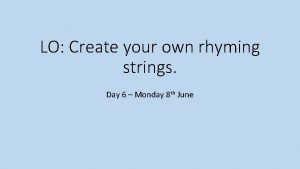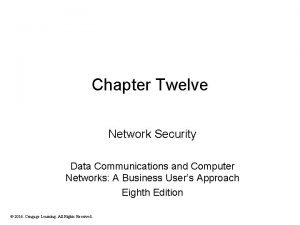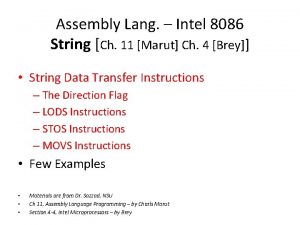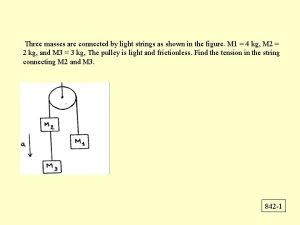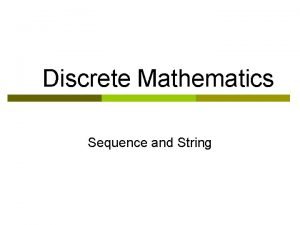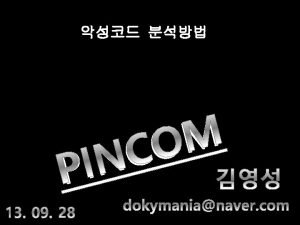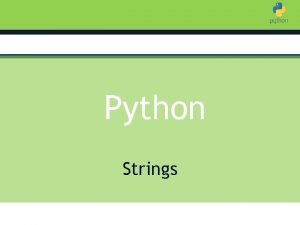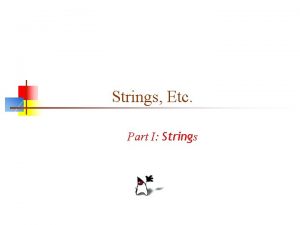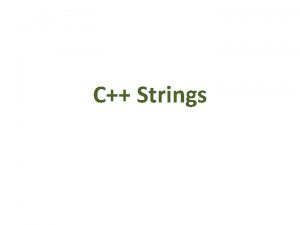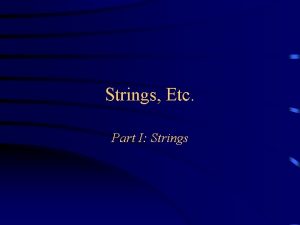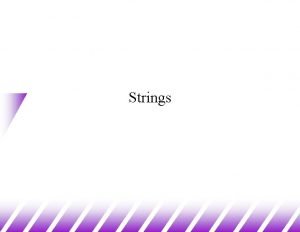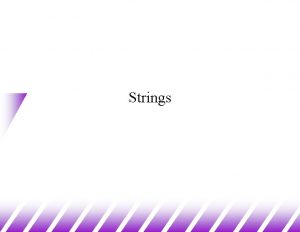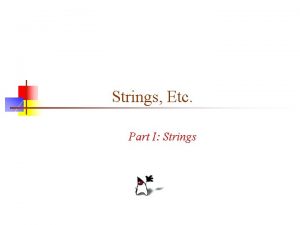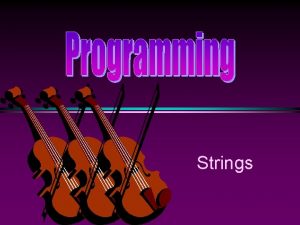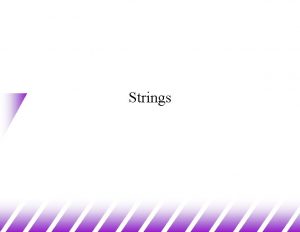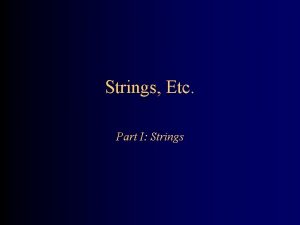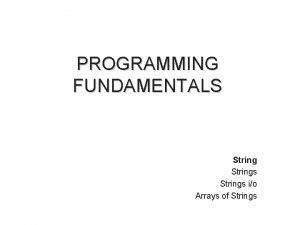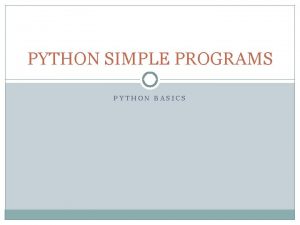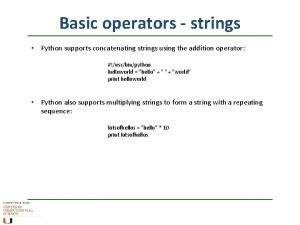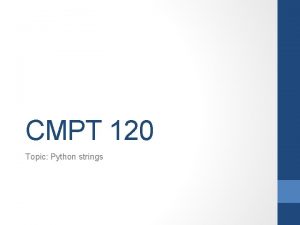Learning to Program in Python Concept 3 STRINGS

















- Slides: 17

Learning to Program in Python Concept 3 STRINGS

Learning Intentions From this lesson the students will be able to: – Understand the concept of a string – Retrieve and Replace characters in strings – Slice a string into sub-strings – Write strings to a file LO 2. 16 students should be able to use data types that are common to procedural high-level languages

STRINGS Our very first line of code we wrote in the IDE was: “hello world” is an example of a string. You can enclose it in single quotes also. (‘hello world’)

STRINGS • A string is a data type. • Each individual member of a string is a character such as “A” or “ 1” or “!” or “ “. (These characters are in fact strings of length 1)

STRINGS • The characters can be accessed by their index or place in the string. • The first index is ZERO • Let’s try some examples in your IDE

Go to your shell (IDE) and figure out some of these String Methods LO 2. 20 students should be able to identify and fix/debug warnings and errors in computer code and modify as required

Notice that the last command below reports an error. The string cannot be assigned a value in this way. Strings are said to be IMMUTABLE. (See the Python Docs in your Python Shell. Go to the Tutorial)

Escape Characters( ) Remember : If we want to print a string and then on the next line print another string we use the backslash followed by the letter n. print(“First Line. n. Second Line. ”) (backslash () is known as an escape character in Python)

Escape Characters( ) • “t” Inserts a tab for example • “”” The backslash here escapes the quotes and so this would print out a set of quotes. • (See the Strings section in Python Docs Tutorials. )

Length of a String (Len) A very useful function in programming is finding the Length of a string. Try the code below. LO 1. 22 students should be able to read, write, test, and modify computer programs

a = ‘Happy’ b = ‘Birthday’ + Concatenation a + b gives ‘Happy. Birthday’ * Repetition a * 3 gives ‘Happy’ [] Slice b[1] gives ‘i’ [: ] Range Slice a[: 2] + b[5: ] gives ‘Haday’ = Assignment c = b gives c =‘Birthday’ and c is separate from b. += Assignment & c += ‘ Boy’ gives c as ‘Birthday Boy’ concatenation in Membership ‘p’ in a gives True (or 1) ‘q’ in a gives False (or 0) False? ‘t’ in a gives

What line of code could be behind me? What line of code is behind me? What line of code could be behind me?

CHALLENGE 1. Ask the user to type in a 4 letter word – For example “mart” 2. If the length of the word is not 4, ask user again. 3. Reverse the string and output as a new string – From the example above : “tram” LO 1. 7 students should be able to develop algorithms to implement chosen solutions

CHALLENGE 1. Ask the user to type in a 4 letter word – For example “mart” 2. If the length of the word is not 4, ask the user again. 3. Reverse the string and output as a new string – From the example above : “tram” How would you output result to a txt file? LO 1. 7 students should be able to develop algorithms to implement chosen solutions

Hint for the Challenge

Brain Teasers 1. If the user typed in a string of length 5, what would your program do? 2. How would you change your program to handle a string of any length? ( Remember the len()method. ) LO 2. 21 students should be able to critically reflect on and identify limitations in completed code and suggest possible improvements

Lesson Review As a result of this lesson I am able to: – Understand the concept of a string – Retrieve and Replace characters in strings – Slice a string into sub-strings – Write strings out to a file The computation challenge for this section asks the students to : 1. Consider their code to reverse a 4 letter string 2. Combine their code with code already written for a User Interface (UI) 3. Modify the new program to ensure correct functionality LO 2. 9 students should be able to assemble existing algorithms or create new ones that use functions (including recursive), procedures, and modules
 Ascii history
Ascii history Concept learning task in machine learning
Concept learning task in machine learning Cuadro comparativo de e-learning
Cuadro comparativo de e-learning Arrays in arm assembly
Arrays in arm assembly Strings in java
Strings in java Elastic strings and springs
Elastic strings and springs Image search reverse
Image search reverse Rate of energy transfer by sinusoidal waves on strings
Rate of energy transfer by sinusoidal waves on strings Pointers and strings
Pointers and strings Is sahunay a membranophone
Is sahunay a membranophone Mason nagy
Mason nagy Rhyming strings
Rhyming strings A type of cipher that uses multiple alphabetic strings.
A type of cipher that uses multiple alphabetic strings. Cld 8086
Cld 8086 Achievement standards network
Achievement standards network Three masses are connected by strings
Three masses are connected by strings Sequences discrete math
Sequences discrete math Upx decompiler
Upx decompiler
